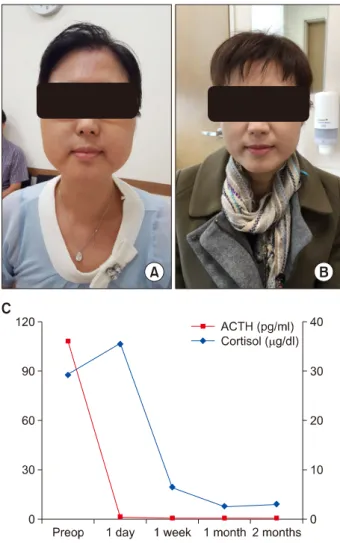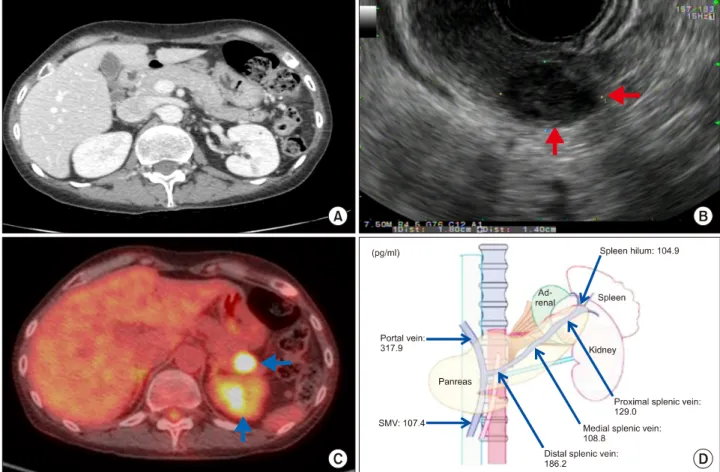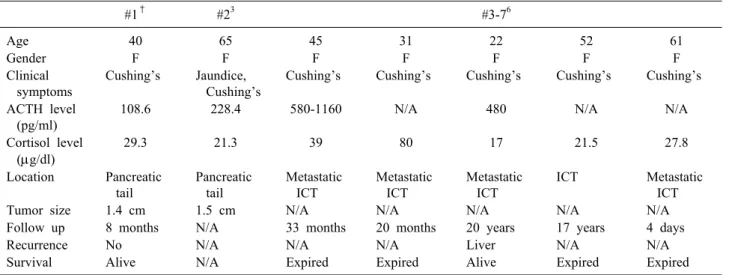ACTH-producing neuroendocrine tumor of the pancreas:
a case report and literature review
Justin Byun1, Sung Hyun Kim2,3, Hyang Sook Jeong4, Yumie Rhee5, Woo Jung Lee2,3, and Chang Moo Kang2,3
1Medical Course, Yonsei University College of Medicine, 2Division of Hepatobiliary and Pancreatic Surgery, Department of Surgery, Yonsei University College of Medicine, 3Pancreaticobiliary Cancer Clinic, Yonsei Cancer Center, Severance Hospital, Departments of 4Pathology and 5Endocrinology, Yonsei University College of Medicine,
Seoul, Korea
Tumors that arise from the endocrine pancreas, or the islets of pancreas, are called pancreatic neuroendocrine tumors (NETs). Pancreatic NET have an incidence of <0.1 per one million persons, and can lead to secretion of ectopic adrenocorticotropic hormone (ACTH). Herein, we presented a case of patient with Cushing’s syndrome as a result of ACTH-producing pancreatic NET, who underwent successful laparoscopic distal pancreatosplenectomy. A 40-year-old Korean female patient with ophthalmologic discomfort, osteoporosis, and unexplained hypokalemia was admitted to our hospital. Under the suspicion of ACTH producing pancreatic NET after the diagnostic workup, we de- cided to perform surgical resection. Laparoscopic distal pancreatosplenectomy was performed; and the pathological examination revealed a 1.5 cm-sized grade 2 neuroendocrine tumor of the pancreas, which was encapsulated within the pancreatic parenchyma. After the operation, the patient no longer displayed cushingoid features. ACTH-producing pancreatic NET is rare, but can be one of the causes of Cushing’s syndrome. Surgical resection is a feasible option in treating ACTH-producing pancreatic NET. (Ann Hepatobiliary Pancreat Surg 2017;21:61-65)
Key Words: ACTH; Neuroendocrine tumor; Pancreas; Surgery
Received: August 12, 2016; Revised: September 15, 2016; Accepted: September 26, 2016 Corresponding author: Chang Moo Kang
Division of Hepatobiliary and Pancreatic Surgery, Department of Surgery, Yonsei University College of Medicine, 50-1 Yonsei-ro, Seodaemun-gu, Seoul 03722, Korea
Tel: +82-2-2228-2100, Fax: +82-2-313-8289, E-mail: cmkang@yuhs.ac
Copyright Ⓒ 2017 by The Korean Association of Hepato-Biliary-Pancreatic Surgery
This is an Open Access article distributed under the terms of the Creative Commons Attribution Non-Commercial License (http://creativecommons.org/
licenses/by-nc/4.0) which permits unrestricted non-commercial use, distribution, and reproduction in any medium, provided the original work is properly cited.
Annals of Hepato-Biliary-Pancreatic Surgery ∙ pISSN: 2508-5778ㆍeISSN: 2508-5859
INTRODUCTION
Tumors that arise from the endocrine pancreas, or the islets of pancreas, are called pancreatic neuroendocrine tu- mors (NETs). NETs account for 1-3% of pancreatic tu- mors; however, the incidence of NETs is reported to be on the rise.1,2 The most well-known functional NETs in- clude gastrinoma, insulinoma, glucagonoma, somatostati- noma, and vasoactive intestinal peptide tumor (VIPoma).
However, NETs that produce ACTH have been reported, despite their lower prevalence than the other types of functional tumors.3
Uncontrolled production of ACTH can lead to the in- crease in glucocorticoid level, resulting in Cushing’s syndrome. More than 80% of Cushing’s syndrome is asso- ciated with autonomous pituitary ACTH secretion; how-
ever, it is well documented that approximately 4-18% of Cushing’s syndrome is due to ectopic ACTH secretion.4 Pancreatic NET has an incidence of <0.1 per one million persons, and can lead to ectopic ACTH secretion.5 In a review of 42 select cases of islet tumor, Clark et al.6 re- ported that two-thirds of the patients presented with weight gain, acne, diabetes mellitus, and hypokalemic alkalosis. In Korea, Song et al.7 previously reported a 52-year-old male patient with ACTH-producing pancreatic NET accompanying multiple liver metastases. However, the study was limited to understanding the natural courses of the tumor biology. Herein, we presented a case of a patient with Cushing’s syndrome as a result of ACTH-producing pancreatic NET, who underwent suc- cessful laparoscopic distal pancreatosplenectomy, with a brief review of the relevant literature.
Fig. 1. Patient follow-up. (A) Preoperation, (B) Postoperation, (C) ACTH and cortisol.
CASE
A 40-year-old Korean female patient with ophthalmo- logic discomfort, osteoporosis, and unexplained hypo- kalemia was admitted. She had undergone ptosis surgery multiple times due to discomfort in the eyes (three times in 2010 and four times in January of 2015). She had no reported use of steroid other than one time in March of 2015 for eye discomfort. However, the patient started to display prominent cushingoid appearance including moon-face, extremity weakness, amenorrhea, pene- trative-looking skin, easy bruising, and buffalo-hump (Fig.
1A).
In laboratory workup, elevated serum ACTH at 108.6 pg/ml (normal range: 7.2-63.3 pg/ml) and urinary free cortisol at 721.6 g/day (normal range: 20-90 g/day) were noted. In addition, serum cortisol was elevated at
29.3 g/dl (Fig. 1C). Cortisol level was not suppressed with high-dose dexamethasone suppression test. Sella MRI revealed no abnormal signal intensity or abnormal mass lesion. Abdomen-pelvis computerized tomography (CT) showed no mass lesions in the abdominal organs (Fig. 2A). However, endoscopic ultrasonography (EUS) confirmed a hypoechoic, homogenous, solid mass with size of 1.8 cm in the pancreatic tail (Fig. 2B). In addition, PET revealed a low-density lesion at the pancreatic tail showing prominent FDG uptake (Fig. 2C). Under the sus- picion of ACTH producing pancreatic NET, venous sam- pling was performed to verify autonomous hormone production. ACTH was measured from six different locations. At all locations, the ACTH level was above normal (Fig. 2D). Therefore, we decided to perform surgi- cal resection. Laparoscopic distal pancreatosplenectomy using modified lasso technique, which includes isolation and ligation of the splenic artery prior to lasso technique, was performed.8 The operation time was approximately 90 mins. The patient was transferred to the department of en- docrinology for close monitoring of the hormonal status on postoperative 7th day with no clinically relevant complications. The pathological examination revealed a 1.5 cm-sized grade 2 neuroendocrine tumor of the pan- creas, which was encapsulated within the pancreatic pa- renchyma (Fig. 3A). No lymph node metastasis was noted (pT1N0M0). The resection margin was free from tumor.
Tumor cells were strongly positive for chromogranin A, synpatophysin, and ACTH in (Fig. 3B-D).
The serum ACTH and cortisol values were restored to the normal cut-off values immediately after the surgical removal of the neuroendocrine tumor (Fig. 1C). In corre- lation with the decreased cortisol level, the patient no lon- ger displayed cushingoid features; and central obesity and the moon-face characteristic were improved significantly (Fig. 1B).
DISCUSSION
Due to the rarity of ACTH-producing pancreatic NETs and difficulty of performing curative resection, only a few cases have been reported.3,6 In our patient, surgical re- moval of the functioning NET of the pancreas alleviated most of the symptoms associated with Cushing’s syndrome. Most notably, the ACTH and cortisol level
Fig. 2. Preoperative findings. (A) Adrenal Computed Tomography: No remarkable finding in both adrenal glands. (B) Endoscopic ultrasonography: 18 mm-sized solid mass was localized to the pancreatic tail. Echo intensity was hypoechoic and echo texture was homogenous (black arrows). (C) Uptake at the pancreatic tail in positron emission tomography (white arrows). (D) ACTH sampling from the pancreatic, splenic, and portal vein.
Fig. 3. Postoperative findings. (A) Gross specimen, (B) Ki-67, (C) Chromogranin A, (D) Synaptophysin, and (E) ACTH (×100).
dropped almost immediately after the resection of the tumor. We summarized similar cases that have been pre- viously reported in the literature (Table 1).
Herein, we showed five selected patients from Clark’s review of 42 patients with islet tumor.6 Of the 42 cases, most of the patients (64%) were women with the mean
Table 1. Characteristics of the present case and select reported cases
#1† #23 #3-76
Age 40 65 45 31 22 52 61
Gender F F F F F F F
Clinical symptoms
Cushing’s Jaundice, Cushing’s
Cushing’s Cushing’s Cushing’s Cushing’s Cushing’s ACTH level
(pg/ml)
108.6 228.4 580-1160 N/A 480 N/A N/A
Cortisol level (g/dl)
29.3 21.3 39 80 17 21.5 27.8
Location Pancreatic tail
Pancreatic tail
Metastatic ICT
Metastatic ICT
Metastatic ICT
ICT Metastatic
ICT
Tumor size 1.4 cm 1.5 cm N/A N/A N/A N/A N/A
Follow up 8 months N/A 33 months 20 months 20 years 17 years 4 days
Recurrence No N/A N/A N/A Liver N/A N/A
Survival Alive N/A Expired Expired Alive Expired Expired
†Our case. ACTH, adrenocorticotropic hormone; ICT, islet cell tumor; N/A, not available
age of 39.8 years, and 66% of the patients initially pre- sented with cushingoid features. Metastases occurred in 88% of the patients and 60% were dead in ≤24 months.
These results emphasize the aggressive nature of ACTH- producing islet cell tumors.
Marcos and Lila3 reported a case of a 65-year old Caucasian female patient with ectopic ACTH neuro- endocrine tumor of the pancreas who presented with facial swelling, weight gain, as well as increased facial hair.
Abdominal CT revealed a calcified mass of approximately 1.5 cm2 within the pancreatic tail. Patient’s initial ACTH and cortisol levels were elevated (228.4 pg/ml and 21.3
g/dl, respectively). Laparoscopic distal pancreatectomy was performed. Subsequent pathology revealed neuro- endocrine carcinoma. Post-surgery, the ACTH and cortisol levels returned to normal and the patients’ symptoms subsided. This case demonstrates the importance and bene- fits of laparoscopic resection.
However, such surgical resection has not been con- ducted previously in Korea. To our best knowledge, this report is the first case of successfully treated Cushing’s syndrome due to pancreatic neuroendocrine tumor produc- ing autonomous ACTH via laparoscopic distal pan- creatosplenectomy in Korea. Prior to our case, a 72-year-old woman with a history of general weakness was diagnosed with elevated serum cortisol level of 120
g/dl. Abdominal CT revealed hypovascular masses in the pancreas. However, due to the patient’s general weakness and old age, neither the biopsy nor the surgery was
performed.9
The reported cases collectively suggest that most pa- tients with pancreatic ACTH-producing pancreatic NET were females and initially presented with cushingoid fea- tures; however, further analysis is required to confirm these findings. As previously reported, the 5-year survival rate of patients with pancreatic islet cell tumor and Cushing’s syndrome is 16% with frequent metastases.6
Consequently, patient’s progress must be closely moni- tored even after surgical removal. At the three-month fol- low-up post-surgery, our patient showed no symptoms of such manifestations. Currently, there is no unified treat- ment algorithm after curative resection. Therefore, fol- low-up study of our case will be helpful in understanding the natural course of resected ACTH-producing NET of the pancreas.
In summary, ACTH-producing pancreatic NET is rare, but can be one of the causes of Cushing’s syndrome.
Based on the literature review, curative resection is diffi- cult because of concomitant multiple liver metastases, and a significant number of cases are associated with lymph node metastasis; however, laparoscopic distal pan- creatosplenectomy can be one of the options in treating left-sided ACTH-producing pancreatic NET.
REFERENCES
1. Yao JC, Hassan M, Phan A, Dagohoy C, Leary C, Mares JE, et al. One hundred years after "carcinoid": epidemiology of and
prognostic factors for neuroendocrine tumors in 35,825 cases in the United States. J Clin Oncol 2008;26:3063-3072.
2. Milan SA, Yeo CJ. Neuroendocrine tumors of the pancreas. Curr Opin Oncol 2012;24:46-55.
3. Marcos C, Lila C. Ectopic ACTH secretion by islet cell neuro- endocrine carcinoma: case report and review of the literature.
World J Med Surg Case Rep 2013;2:56-63.
4. Doppman JL, Nieman LK, Cutler GB Jr, Chrousos GP, Fraker DL, Norton JA, et al. Adrenocorticotropic hormone--secreting is- let cell tumors: are they always malignant? Radiology 1994;190:
59-64.
5. Patel FB, Khagi S, Daly KP, Lechan RM, Ummaritchot V, Saif MW. Pancreatic neuroendocrine tumor with ectopic adrenocorti-
cotropin production: a case report and review of literature.
Anticancer Res 2013;33:4001-4005.
6. Clark ES, Carney JA. Pancreatic islet cell tumor associated with Cushing's syndrome. Am J Surg Pathol 1984;8:917-924.
7. Song EM, Lee KE, Jo JY, Koo HS, Choi MY, Seong CM, et al. An adrenocorticotropic hormone-secreting malignant pancre- atic neuroendocrine tumor. Korean J Med 2011;80:238-242.
8. Velanovich V. The lasso technique for laparoscopic distal pancreatectomy. Surg Endosc 2006;20:1766-1771.
9. Hwang JH, Han SS, Cho EJ, Kim DK, Oh KH, Joo KW, et al.
Ectopic ACTH syndrome and severe hypokalemia associated with suspicious pancreatic malignancy: a case report. Korean J Nephrol 2010;29:606-610.


